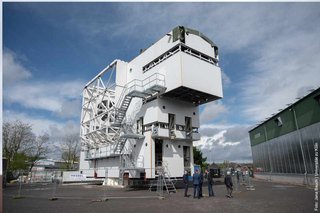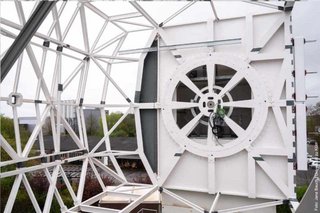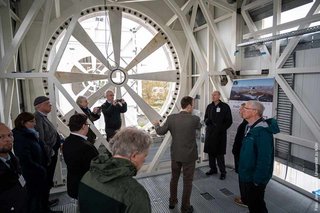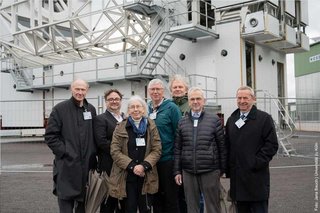On 04 April 2024, the new Fred Young Submillimeter Telescope (FYST) was presented in Xanten on the Lower Rhine. Apart from keynotes on the scientific background and technical peculiarities, the team demonstrated the movement of the FYST and offered guided tours so the participants were able to get an impression of the new telescope design. The FYST is a state-of-the-art telescope with a mirror diameter of six meters. This means that it is designed to operate at submillimetre to millimetre wavelengths. It will provide insights into the formation of the first stars after the Big Bang and into the formation of stars and galaxies in general. “The novel optical design of FYST will deliver a high-throughput, wide-field of view telescope capable of mapping the entire southern hemisphere sky very rapidly and efficiently. We are trying to understand no less than the origin and development of our universe since the Big Bang,” said Professor Dr Dominik Riechers from the Institute for Astrophysics of the University of Cologne.
“It is an extraordinary achievement that universities such as the universities of Bonn and Cologne can contribute to the establishment of such a large research infrastructure. This is only possible thanks to long-term planning. We would like to thank all our sponsors and consortium partners,” said Karsten Gerlof, Chancellor of the University of Cologne. In addition, Professor Dr Stephanie Walch-Gassner (President of the German Astronomical Society, Institute for Astrophysics at the University of Cologne), Thomas Görtz (Mayor of the city of Xanten), Edeltraud Klabuhn (Mayor of the city of Duisburg) and Chapman Godbey (U.S. Consulate General Düsseldorf) welcomed the participants.
Following the event, the FYST will initially be further developed. At the end of the year, its components will be disassembled and transported to its final location in the Chilean Atacama Desert. It will be located at 5,600 metres elevation on Cerro Chajnantor in Chile, overlooking the ALMA array. The observations of the wide-field telescope at submillimetre wavelengths are slightly distorted by water vapour in the Earth's atmosphere and the signal is greatly attenuated. Therefore, a high and dry site is required.
Partners in the project are Cornell University (USA), a German consortium of the University of Cologne, the University of Bonn and the Max Planck Institute for Astrophysics in Garching as well as a Canadian consortium of several universities. The telescope was designed by Vertex Antennentechnik in Duisburg. The FYST was assembled in Xanten on the site of Wessel GmbH. It was named after Fred Young, who was involved in the project for many years and generously contributed to its funding.



